I am trying to detect the vehicle from the video , I 'll do it in real time application but for the time being and for good understanding i am doing it on video , code is below:
void surf_detection(Mat img_1,Mat img_2); /** @function main */
int main( int argc, char** argv )
{
int i;
int key;
CvCapture* capture = cvCaptureFromAVI("try2.avi");// Read the video file
if (!capture){
std::cout <<" Error in capture video file";
return -1;
}
Mat img_template = imread("images.jpg"); // read template image
int numFrames = (int) cvGetCaptureProperty(capture, CV_CAP_PROP_FRAME_COUNT);
IplImage* img = 0;
for(i=0;i<numFrames;i++){
cvGrabFrame(capture); // capture a frame
img=cvRetrieveFrame(capture); // retrieve the captured frame
surf_detection (img_template,img);
cvShowImage("mainWin", img);
key=cvWaitKey(20);
}
return 0;
}
void surf_detection(Mat img_1,Mat img_2)
{
if( !img_1.data || !img_2.data )
{
std::cout<< " --(!) Error reading images " << std::endl;
}
//-- Step 1: Detect the keypoints using SURF Detector
int minHessian = 400;
SurfFeatureDetector detector( minHessian );
std::vector<KeyPoint> keypoints_1, keypoints_2;
std::vector< DMatch > good_matches;
do{
detector.detect( img_1, keypoints_1 );
detector.detect( img_2, keypoints_2 );
//-- Draw keypoints
Mat img_keypoints_1; Mat img_keypoints_2;
drawKeypoints( img_1, keypoints_1, img_keypoints_1, Scalar::all(-1), DrawMatchesFlags::DEFAULT );
drawKeypoints( img_2, keypoints_2, img_keypoints_2, Scalar::all(-1), DrawMatchesFlags::DEFAULT );
//-- Step 2: Calculate descriptors (feature vectors)
SurfDescriptorExtractor extractor;
Mat descriptors_1, descriptors_2;
extractor.compute( img_1, keypoints_1, descriptors_1 );
extractor.compute( img_2, keypoints_2, descriptors_2 );
//-- Step 3: Matching descriptor vectors using FLANN matcher
FlannBasedMatcher matcher;
std::vector< DMatch > matches;
matcher.match( descriptors_1, descriptors_2, matches );
double max_dist = 0;
double min_dist = 100;
//-- Quick calculation of max and min distances between keypoints
for( int i = 0; i < descriptors_1.rows; i++ )
{
double dist = matches[i].distance;
if( dist < min_dist )
min_dist = dist;
if( dist > max_dist )
max_dist = dist;
}
//-- Draw only "good" matches (i.e. whose distance is less than 2*min_dist )
for( int i = 0; i < descriptors_1.rows; i++ )
{
if( matches[i].distance < 2*min_dist )
{
good_matches.push_back( matches[i]);
}
}
}while(good_matches.size()<100);
//-- Draw only "good" matches
Mat img_matches;
drawMatches( img_1, keypoints_1, img_2, keypoints_2,good_matches, img_matches, Scalar::all(-1), Scalar::all(-1),
vector<char>(), DrawMatchesFlags::NOT_DRAW_SINGLE_POINTS );
//-- Localize the object
std::vector<Point2f> obj;
std::vector<Point2f> scene;
for( int i = 0; i < good_matches.size(); i++ )
{
//-- Get the keypoints from the good matches
obj.push_back( keypoints_1[ good_matches[i].queryIdx ].pt );
scene.push_back( keypoints_2[ good_matches[i].trainIdx ].pt );
}
Mat H = findHomography( obj, scene, CV_RANSAC );
//-- Get the corners from the image_1 ( the object to be "detected" )
std::vector<Point2f> obj_corners(4);
obj_corners[0] = Point2f(0,0);
obj_corners[1] = Point2f( img_1.cols, 0 );
obj_corners[2] = Point2f( img_1.cols, img_1.rows );
obj_corners[3] = Point2f( 0, img_1.rows );
std::vector<Point2f> scene_corners(4);
perspectiveTransform( obj_corners, scene_corners, H);
//-- Draw lines between the corners (the mapped object in the scene - image_2 )
line( img_matches, scene_corners[0] , scene_corners[1] , Scalar(0, 255, 0), 4 );
line( img_matches, scene_corners[1], scene_corners[2], Scalar( 0, 255, 0), 4 );
line( img_matches, scene_corners[2] , scene_corners[3], Scalar( 0, 255, 0), 4 );
line( img_matches, scene_corners[3] , scene_corners[0], Scalar( 0, 255, 0), 4 );
imshow( "Good Matches & Object detection", img_matches );
}
I am getting the following output

and std::cout << scene_corners[i] (Result)
![std::cout << scene_corners[i] (Result)](../../images/3829796004.webp)
Value of H:

But my question is why its not drawing rectangle on the object which is detected like:

I am doing this on simple video and image , but when i did it on still camera so it may difficult without that rectangle